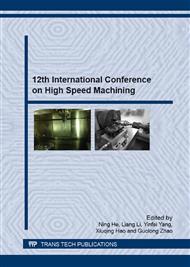p.270
p.277
p.283
p.290
p.296
p.304
p.310
p.318
p.326
Experimental Analysis of Damping Fixture for Thin-Walled Workpiece Milling
Abstract:
Thin-walled workpieces are widely used in the aerospace manufacturing industry in order to reduce the weight of structure and improve working efficiency. However, vibration is easy to occur in machining of thin-walled structures due to its low stiffness. Machining vibration will result in lower machining accuracy as well as machining efficiency. In order to reduce the machining vibrations of thin-wall workpieces, commonly used method is to select proper machining parameters according to the chatter stability lobes, which is generated according to the machining system parameters. However, this method requires exact system parameters to be determined, which are always changing in the machining process. In this paper, a special designed fixture with damping materials for the thin-walled workpiece is presented based on the machining vibration control theory, and analysis of the effect of vibration suppressing is obtained through the contrast of vibration tests of milling the thin-walled workpiece on the damping clamp. The damping material is used to consume vibration energy and provide support for thin-walled structure. Machining test was carried out for thin-walled structure machining to validate the effectiveness of the proposed method.
Info:
Periodical:
Pages:
296-303
Citation:
Online since:
January 2016
Authors:
Keywords:
Price:
Сopyright:
© 2016 Trans Tech Publications Ltd. All Rights Reserved
Share:
Citation:


